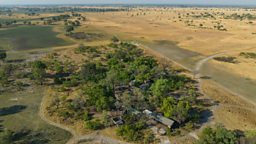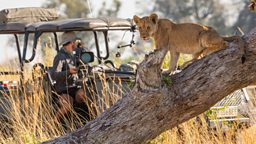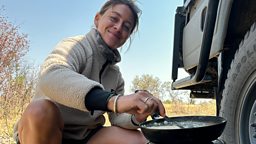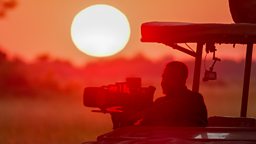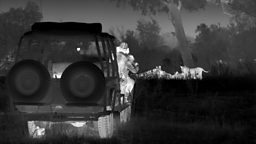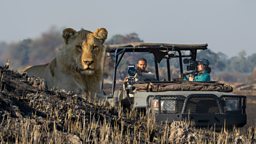Creating a production hub in the Delta
By Gillian Goodlet, Production Manager

I’ve been working in television production for longer than I care to remember, and, just when I was about to hang up my TV boots, I somehow stumbled across “Big Cats 24/7”. It has turned out to be one of the highlights of my career.
we are fortunate to be based at the same location across a sustained period
There have been many challenges, but we are blessed with an exceptional team, both here in the UK and in Botswana. There has also been the opportunity to spend time in the glorious Okavango Delta; to see firsthand the prolific wildlife, richly coloured birds, the beautiful sunlit grasses infused with the smell of wild sage and, of course – the cats. It’s hard not to fall in love with the cats, and to root for them as they face the daily perils and pleasures of life in the Delta.
Our filming location is an area covering 150 square miles and at its heart, surrounded by a free flow of incredible African animals, is a remote film camp built by wildlife filmmaker Brad Bestelink. Brad grew up in the Okavango Delta and knows it intimately. Working together with him, and his team of talented local crew and cinematographers, we have been able to support an industrious production hub on location – and also build a much valued partnership with our UK team.
Brad and his team have built an impressive filming camp on Xudum Island, but it was touch and go if it would be ready for our production’s arrival. When our collaboration began, Brad was in the process of moving his operations to this new film camp. But he had to build it first! With planning permission coming through right at the last minute, it was a close call that we would get there. But he pulled it off – and created an incredible space for our operations to begin.

A bull elephant roams through camp
Cameraman Greg stands up to a huge bull elephant that is roaming around the film camp.
Despite the rapid build, Brad’s camp still has green credentials at its core. The camp itself was built almost entirely by recycling old structures and materials; a number of large solar panels provide energy to support the main electricity needs of the camp on a daily basis; the water is supplied via the camp’s own borehole which is also pumped and heated via the solar set up, feeding hot water to all the cabins for crew and staff; and all the waste from camp is either eco-treated on site and re-used, or transported back to Maun for recycling on a monthly basis.

However, one of the main concerns I had was whether the power supply in such a remote location would be robust enough to support the daily turnaround of media processing of all our cameras which included 2 thermal systems for night time filming, 8 cameras for filming wildlife and 6 for filming people plus drones and small action cameras - as well as the charging of all that kit each night.
There were many head scratching conversations with our respective tech teams, drawing up dizzying charts and spreadsheets to investigate workable solutions to the question of power and media storage needs, whilst staying within budget. With minimum lead time for the project we had to make swift decisions in order to be ready for the start of filming.
Like the rest of natural history production it’s all about problem-solving; whether that’s coping with the unpredictability of extreme weather patterns and conditions; or the frustrating vagaries of animal behaviour; or the complex logistics of transporting crew, camera and survival kit across far flung borders and isolated territory; as well as the pressure of developing innovative filming techniques to capture new and unseen animal behaviour and producing images to inspire and encourage an increasingly sophisticated audience to care deeply about the natural world.
In the end, for our particular production hub conundrum, we took a calculated gamble on a package that has served us well to this day. With time running out and options diminishing, there wasn’t really a viable Plan B so it was a huge relief when we got to camp and discovered that it all worked!

Many natural history programmes film all over the world, across many continents, focussing on each place for a short amount of time. For me, one of the many benefits of working on Big Cats 24/7 is that we are fortunate to be based at the same location for a sustained period.
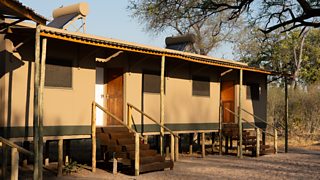
Being in the same location allows us to spend meaningful time with our cat characters, as well as forging valuable and rewarding relationships with our Botswanan colleagues that we hope will continue to grow and flourish.
During the filming period the entire centre of operations moves from the UK to Botswana and again, unlike a lot of other Natural History programmes, every member of the team spends time on location, supporting the film unit to be as productive and comfortable as possible. The pace of filming and development of storylines is so rapid that the necessary exchange of information and lines of communication are pretty much open 24 hours a day!
Getting our production machine up and rolling was certainly a challenge, but when we finally arrived in the brand new camp and, following a few days of tests and tweaks, plus the help of some giant sized solar panels, everything worked well. With a huge sense of relief, we felt prepped and ready for filming. What could possibly go wrong…? Well, if you watch episode one, you’ll find out!
